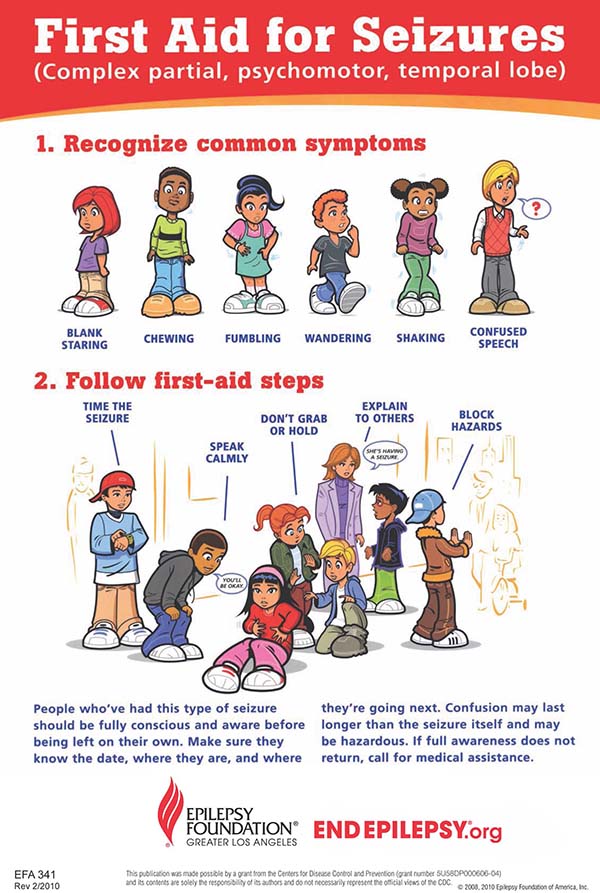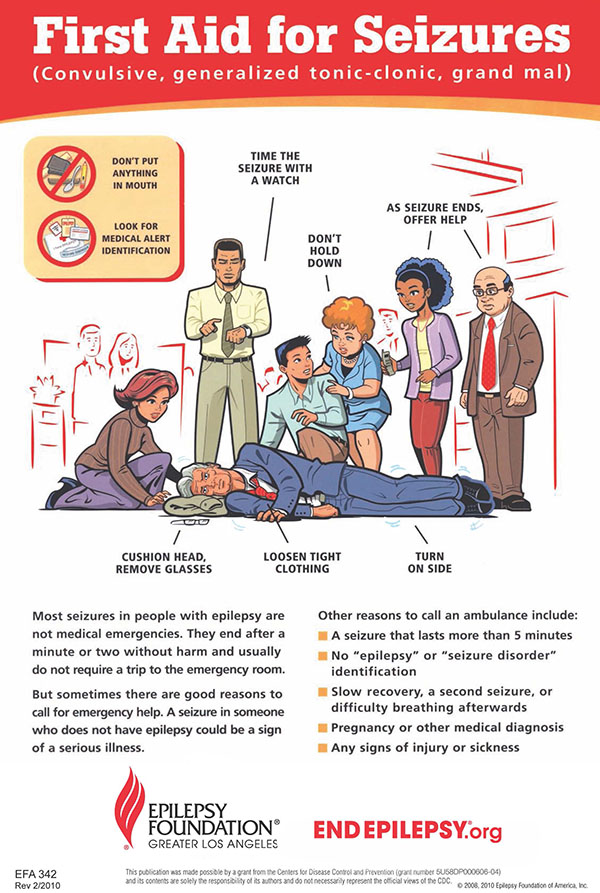Epilepsy and Seizures: Fighting the Fear and Unknown
Part 2: First Aid for Seizures
By Trish Hughes Kreis for Assisted Living Directory
***A personal note here from David, Assisted Living Directory’s founder. I was skiing this year, and a fellow skier passed me, dropped to the ground, and had a serious, violent seizure. I was, as Trish describes below, immobilized out of a lack of knowing what to do. My experience was, in part, inspiration for Trish to write this series for our site.
[Video] What should I do if I witness someone having a seizure?
Since a seizure can strike at any time and there are many different types of seizures, chances are you will witness one at some point. They are not always as portrayed in the movies (see Part 1: Recognizing Seizures). Whether it is in a crowded movie theater, a restaurant, a care facility or ski slope, seizures can happen and generally happen without warning. (Some people do have an “aura” before a seizure which can provide just enough time to find a safe place before the seizure strikes.)
I have heard complaints from people about everyone standing around staring while their loved one has a seizure. Since I believe people are basically good (why else do we love to root for the underdog or cry at commercials involving lost dogs and the horses who save them?), I think people are staring and immobilized out of a lack of knowledge of what to do. People want to help but are unsure what to do!
The next time you recognize what you think might be a seizure, use these eight tips to ensure the safety of the person having a seizure and satisfy the basic instinct in you to help:
- Assess the Situation. Is the person having a seizure alone or with someone? If there is a companion with the person having a seizure, politely ask if they need assistance. If the seizure caused an injury, the companion may ask you to call 911. The companion may not want any assistance but if they do, please help with what they tell you they need – the companion most likely has experience with this and will best know what is needed in the situation. If the person is alone, check to see if they are wearing a medical alert bracelet.
- Safety First. Be sure the person having the seizure is safe. Have they fallen? Clear away any objects that may cause the person harm. Are they standing but about to fall? If possible and safe, help lower them to the ground.
- Keep them Comfortable. If it is possible without causing harm to the person having a seizure or others, roll the person on to their side. Remove the person’s eye glasses. Place something soft under their head (a rolled up sweatshirt, for instance).
- Time the Seizure/Note Behavior. It is important for the person with epilepsy to know how long the seizure lasted and what happened during the seizure. If possible, keep track of the length of time the seizure lasted and if there were any movements, such as tugging at clothes, smacking of lips, sounds, etc. All these types of observations are helpful to the person with epilepsy and their neurologist.
- Crowd Control. A bystander witnessing a seizure can help by making sure people do not crowd around the person having a seizure. It can be extremely disconcerting to come out of a seizure with several strangers staring at you.
- When to Call the Paramedics. It is not always necessary to call 911 when a person has a seizure. However, call 911 if the seizure happened in water or lasts longer than 5 minutes (or if several occur right after another) or if the person has been injured or is having trouble breathing. Also, call 911 if the person does not have a medical alert bracelet on indicating a seizure disorder (this seizure may be their first). Of course, please call for help if the person having a seizure or the companion asks for the help.
- What Not to Do. Do NOT put anything into the person’s mouth. It is a myth that a person can swallow their tongue. Shockingly, this myth persists to this day and putting anything into a person’s mouth during a seizure can cause harm. Do not restrain the person having a seizure and do not perform CPR during a seizure.
- Be Reassuring. If possible, stay with the person during the seizure. Seizures generally last anywhere from a few seconds to a few minutes. Reassure the person as they come out of the seizure. Sometimes people with epilepsy may feel embarrassed about having people witness them having a seizure. Some people with seizures become incontinent which can also be quite embarrassing for them once they are out of the seizure. Be kind and considerate and ask if there is anything else you can do or if there is someone you can call for them (if they are alone).
On a personal note, I would like to thank every person who has ever stopped to help a person having a seizure or who will do so in the future. I have witnessed my brother having seizures his entire life (and he is pushing half a century now!) and seizures still make my stomach turn. I don’t like to witness Robert having a seizure or a cluster of seizures so I know if someone as familiar with seizures as I am is uncomfortable, I can only imagine what it might be like for others who do not have any experience with them at all.
I encourage you to spread this information about seizure first aid so as many people as possible are prepared for that time they witness a seizure.
Thank you from the bottom of my heart for having the courage it takes to help someone in need, particularly in an unknown situation.





